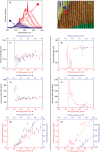Spectral fingerprint of laser emission from rhodamine 6g infused male Indian Peafowl tail feathers
- PMID: 40594122
- PMCID: PMC12216718
- DOI: 10.1038/s41598-025-04039-8
Spectral fingerprint of laser emission from rhodamine 6g infused male Indian Peafowl tail feathers
Abstract
The light-emissive properties of dye-infused barbules from Indian Peafowl (Pavo cristatus) tail feathers is investigated at high intensities pumped at [Formula: see text]nm. The dye-infused barbules were prepared by repeatedly wetting the eyespot with dye solution and allowing it to dry. While wet, and after wet/dry cycling, across multiple parts of the same feather as well as across different feather samples, a highly conserved set of laser wavelengths was observed. While most feedback mechanisms in biological materials have been attributed to random lasers, the results presented in this article are inconsistent with this mechanism, and they suggest a critical structure inside the barbules which persists through different color regions of the eyespot. The laser thresholds were found to be below the random laser threshold for these materials, and the laser emission indicates that feedback structures with small gain volumes can be measured using this technique. This study also illustrates how persistent small-scale structures in biological materials act as low-quality resonators whose dispersion imprints on subsequent laser emission.
Keywords: Biophotonics; Feedback; Laser; Photonic structure.
© 2025. The Author(s).
Conflict of interest statement
Declarations. Competing interests: The authors declare no competing interests.
Figures





References
-
- Schawlow, A. L. & Townes, C. H. Infrared and optical masers. Phys. Rev.112, 1940–1949. 10.1103/PhysRev.112.1940 (1958).
-
- Maiman, T. H. Stimulated optical radiation in ruby. Nature (London)187(4736), 493–494 (1960).
-
- Paschotta, R. Field guide to lasers (SPIE Press, Bellingham, Wash, 2008).
-
- Singer, K. D. et al. Melt-processed all-polymer distributed Bragg reflector laser. Opt. Express16(14), 10358–10363 (2008). - PubMed
-
- Andrews, J. H. et al. Thermo-spectral study of all-polymer multilayer lasers. Opt. Mater. Express3(8), 1152–1160 (2013).
Grants and funding
LinkOut - more resources
Full Text Sources

